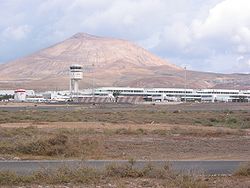Lanzarote Airport
| Aeropuerto de Lanzarote-Arrecife Aeródromo Militar de Lanzarote |
|
|---|---|

|
|
| Characteristics | |
| ICAO code | GCRR |
| IATA code | ACE |
| Coordinates | |
| Height above MSL | 14 m (46 ft ) |
| Transport links | |
| Distance from the city center | about 5 km west of Arrecife |
| Street | LZ-2 |
| Local transport | Bus routes 22, 23, 161 |
| Basic data | |
| opening | 1936 (1970) |
| operator | AENA |
| Terminals | 2 |
| Passengers | 7,389,025 (2017) |
| Air freight | 1825 t (2017) |
| Flight movements |
59,476 (2017) |
| Start-and runway | |
| 03/21 | 2400 m × 45 m asphalt |
The Lanzarote Airport is a Spanish airport on the island of Lanzarote near the island's capital Arrecife . It ranks tenth on the list of airports in Spain (as of the end of 2008) and is the third largest in the Canary Islands after Gran Canaria and Tenerife South . The airport is also used by the Spanish Air Force as the Aeródromo Militar de Lanzarote .
Airlines and Destinations
The airport, which belongs to the island's capital, Arrecife, has direct flights from numerous German airports in around four and a half hours and is also served by Spanish airlines. In the charter several flying British companies to Lanzarote. The majority of passengers from Europe fly in from Great Britain , Germany , Austria and the Netherlands .
history
In 1936 the construction of a makeshift airport began. In the summer of 1940, five kilometers west of Arrecife, on the Costa de Guacimeta in the municipality of San Bartolomé , a military airfield was built to defend the archipelago by the Spanish air force . In 1946 this was provisionally released for civil air traffic and officially opened for domestic flights in 1947 after some renovations. After various expansion work and the construction of an apron in the 1950s, the airport was given a 1850 meter long and 45 meter wide, paved runway with temporary lighting in 1965 .
In 1969 the airport was extensively expanded with a terminal building, apron, energy supply and radio technology, on March 3, 1970 it was opened for international civil passenger air traffic. Due to the steadily growing number of passengers due to increasing tourism, significant improvements in technology and the enlargement of various facilities have been made time and again. In 1999, a 42,000 m², two-storey terminal with 42 check-in counters and, for the first time, closed passenger boarding bridges was opened for six million passengers a year . In addition, there was a new tower and various infrastructure. The now "old" terminal from 1969 has been used as Terminal 2 for flights within the Canary Islands as well as for private and business flights.
Since 2006 the first airport building from 1938 has housed the Museo Aeronáutico , an airport museum on the history of civil and military air traffic on the island.
statistics

|
| As of May 31, 2020 |
| Passengers | Flight movements | Freight (t) | |
|---|---|---|---|
| 2000 | 5,002,551 | 44,814 | 6403 |
| 2001 | 5,079,790 | 43,368 | 7134 |
| 2002 | 5,123,574 | 45,050 | 7201 |
| 2003 | 5,383,426 | 47,667 | 7492 |
| 2004 | 5,517,136 | 48,446 | 7996 |
| 2005 | 5,467,499 | 47,158 | 6629 |
| 2006 | 5,626,087 | 50.172 | 6113 |
| 2007 | 5,625,580 | 52,968 | 5784 |
| 2008 | 5,438,178 | 53,375 | 5429 |
| 2009 | 4,701,669 | 42,915 | 4146 |
| 2010 | 4,938,632 | 46,668 | 3787 |
| 2011 | 5,543,744 | 49,675 | 2873 |
| 2012 | 5,168,775 | 44,787 | 2108 |
| 2013 | 5,334,599 | 44,259 | 2081 |
| 2014 | 5,882,691 | 49,576 | 2052 |
| 2015 | 6,128,971 | 50,448 | 1805 |
| 2016 | 6,684,564 | 54,632 | 1776 |
| 2017 | 7,388,964 | 59,477 | 1824 |
| 2018 | 7,327,129 | 60,955 | 1642 |
| 2019 | 7,292,720 | 60,524 | 1346 |
| Source: Aena operator statistics | |||
Directions
- Bus : Lines 22 and 23 go to Arrecife bus station, line 23 also to Playa Honda and 161 to Playa Blanca.
Individual evidence
- ↑ a b timetable! accessed on March 30, 2014
- ↑ a b c AENA ( Memento of January 13, 2018 in the Internet Archive ) (Spanish) , accessed on December 1, 2018.
- ↑ passenger numbers on the operator's website ; accessed on May 31, 2020
Web links
- Official website of the operator AENA (German)
- Official site of the Spanish Air Force (Spanish)
- Airport data on World Aero Data